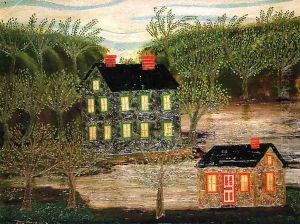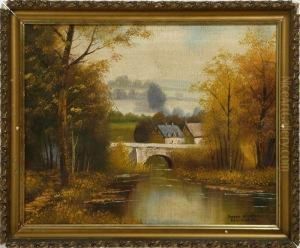Joseph Pickett Paintings
Joseph Pickett was an American folk artist known for his idiosyncratic and naïve style of painting. He was born in 1848 in New Hope, Pennsylvania, and spent much of his life in his hometown, which was also the subject of most of his artwork. Pickett led a varied life, starting as a carpenter and then working as a ship carpenter, grocer, and an innkeeper before turning to painting.
Pickett's work was not widely recognized during his lifetime, and he was very much an outsider artist, self-taught and working on the fringes of the art world. It was only after his death in 1918 that his work began to be appreciated by a broader audience. His most famous painting is 'Manchester Valley' (circa 1914-1918), which depicts a panoramic view of his hometown complete with a detailed, albeit naïve, portrayal of the landscape and architecture of the time.
Pickett's art is characterized by a lack of perspective and his unique use of color and detail. His paintings often have a flat, two-dimensional appearance, with people and objects depicted in a straightforward manner without the use of shading or other techniques to create depth. Despite, or perhaps because of, his unconventional technique, Pickett's work captures a charming and personal vision of American life at the turn of the 20th century.
Joseph Pickett's legacy as a folk artist grew posthumously, and his paintings are now considered important examples of American folk art. His work is held in the collections of several major museums, including the Metropolitan Museum of Art in New York. Pickett is remembered for his unique vision and contribution to the genre of folk art, providing insight into the life and landscape of his time through his distinctive paintings.

